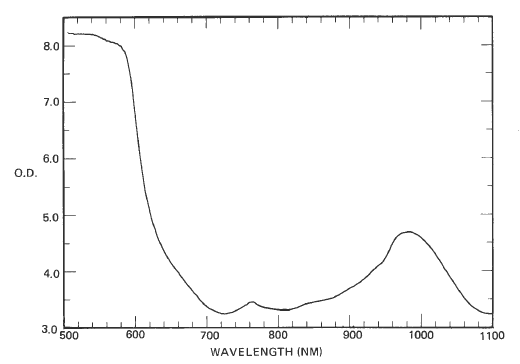PHOTOBIOLOGY in ART
Kendric C. Smith
Emeritus Professor, Radiation Oncology (Radiation Biology)
Stanford University School of Medicine
800 Blossom Hill Road, Unit R169, Los Gatos, CA 95032
kendric@stanford.edu
web.stanford.edu/~kendric/
Since we cannot ordinarily see through the human body, a common misconception that was prevalent in the 1970's was that light only penetrated the body through the eyes. When confronted with this incorrect statement, I simply asked if that person ever played the childhood game of putting the lighted end of a flashlight in his/her mouth while standing before a mirror in a dark room. It is mainly red light
(670-760 nm) that is transmitted through the cheeks.
This is confirmed by the absorption spectrum of a human hand
(Figure 1), which demonstrates that the hand is rather transparent to light of wavelengths between 650 and 900 nm.
An optical density of 3.5 corresponds to a percent transmission (%T) of about 0.5%. Therefore, whether or not you see red light being transmitted through living tissue depends, in part, upon the incident intensity (Io) of the light [%T = I(transmitted)/Io].

Figure 1. The absorption spectrum of a human hand.
The spectrum was recorded with a very sensitive spectrophotometer with the hand in close juxtaposition with the photocathode (unpublished data of Karl H. Norris, from The Science of Photobiology (KC Smith, ed., Plenum Press, 1977; p. 400).
When I saw the painting by Georges De La Tour, "Christ with St. Joseph in the Carpenter's Shop", in the Musee du Louvre in Paris, I was greatly impressed that the artist knew that light penetrated tissues, and that it was the red light that was the most penetrating (Figure 2). There were no flashlights in the 1630's.

Figure 2. "Christ with St. Joseph in the Carpenter's Shop" by Georges De La Tour (Musee du Louvre, Paris). Probably painted in the late 1630's. [the original painting is cropped here to show the detail in the painting]
Yes, light does penetrate tissues, and this is the basis for Low Level Light Therapy (LLLT). In the Module by Dr. Tiina Karu, Action Spectra demonstrate which wavelengths penetrate cells, and which wavelengths are the most effective in stimulating cell growth.
In fact, all aspects of Photobiology, except Bioluminescence, requires the penetration of light through tissues to reach the required light-absorbing target, which then produces the photobiological response.
We now know and appreciate what the artist, Georges De La Tour, already knew in the 1630's.
02/22/11
06/02/11
03/18/14